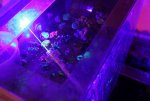To follow up with my previous requirements for killing pest in a reef tank.
2+ watts of 100% duty cycle lasers in the 445nm spectrum. I should be able to leave it on until the batteries die.
First I have to give credit to DTR for shipping those modules out so fast. I've killed a few modules developing this.
Secondly AGM for the fine LPM and survival laser for the base host.
Anyway i've developed a water proof laser. Lasers have a limited range penetrating salt water. I find 6" is roughly the range 2.5W laser has. Anything greater then that it is almost a flashlight. So I can either go dual diode or more (but the power requirements goes up exponentially with distance I need to cover) OR I bring the laser to the target subjects.
While testing I noticed that cooling has a profound effect on power output. Notice the ripples on the LPM graphs. The power increase was caused by me blowing on the cooling fins.
Also note this laser is cable of adjusting focus under water. O-ring seals around the focus knob allows me to do this.
The first LPM graph is to show a cold run. 3.1W dropping to 2.8W after 180 seconds. I had to stop the test because of lack of active cooling. If submerged under water it would stay cool. This is with just the survival laser host with G2 lens.
The 2nd graph is the same test but showing you a run after warm up of the laser with G2 lens.
Finally the last graph shows the power output thru my custom water proof housing. Passing thru another plexiglass lens lowers power output by 200mw or so. BUT i'm guessing I can get that power back due to active cooling of the water surrounding the laser.
Anyway enjoy. The first true 2W+ water proof laser
2+ watts of 100% duty cycle lasers in the 445nm spectrum. I should be able to leave it on until the batteries die.
First I have to give credit to DTR for shipping those modules out so fast. I've killed a few modules developing this.
Secondly AGM for the fine LPM and survival laser for the base host.
Anyway i've developed a water proof laser. Lasers have a limited range penetrating salt water. I find 6" is roughly the range 2.5W laser has. Anything greater then that it is almost a flashlight. So I can either go dual diode or more (but the power requirements goes up exponentially with distance I need to cover) OR I bring the laser to the target subjects.
While testing I noticed that cooling has a profound effect on power output. Notice the ripples on the LPM graphs. The power increase was caused by me blowing on the cooling fins.
Also note this laser is cable of adjusting focus under water. O-ring seals around the focus knob allows me to do this.
The first LPM graph is to show a cold run. 3.1W dropping to 2.8W after 180 seconds. I had to stop the test because of lack of active cooling. If submerged under water it would stay cool. This is with just the survival laser host with G2 lens.
The 2nd graph is the same test but showing you a run after warm up of the laser with G2 lens.
Finally the last graph shows the power output thru my custom water proof housing. Passing thru another plexiglass lens lowers power output by 200mw or so. BUT i'm guessing I can get that power back due to active cooling of the water surrounding the laser.
Anyway enjoy. The first true 2W+ water proof laser









